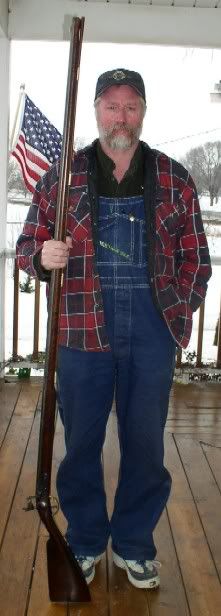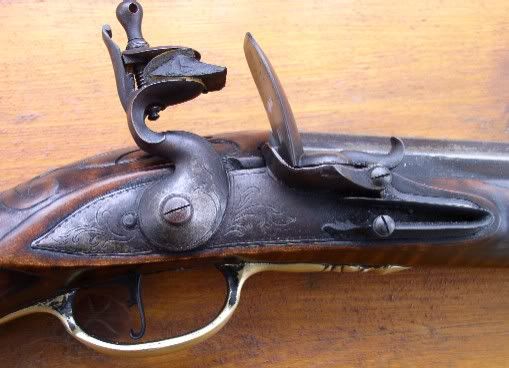I've been wondering about the different barrel lengths fowlers in the 18th century came in. I know most were long- 42"+, some were very long- 48"+, and I have seen a few in books in the smaller 39"-40" range. Has anyone seen such shorter barrels on 18th-century hunting guns and fowling pieces? I know trade guns often came in the 36" or so lengths, I'm thinking more of New England, NY, PA colonial guns. I have also seen a few fowlers with the barrels bobbed or shortened after they were built, I'm not thinking of these either. Any thoughts or observations?
-
Friends, our 2nd Amendment rights are always under attack and the NRA has been a constant for decades in helping fight that fight.
We have partnered with the NRA to offer you a discount on membership and Muzzleloading Forum gets a small percentage too of each membership, so you are supporting both the NRA and us.
Use this link to sign up please; https://membership.nra.org/recruiters/join/XR045103
You are using an out of date browser. It may not display this or other websites correctly.
You should upgrade or use an alternative browser.
You should upgrade or use an alternative browser.
smooth bore barrel lengths
- Thread starter John Tice
- Start date

Help Support Muzzleloading Forum:
This site may earn a commission from merchant affiliate
links, including eBay, Amazon, and others.
Mike Brooks
Cannon
- Joined
- Jul 19, 2005
- Messages
- 6,686
- Reaction score
- 33
Everything I've seen in the areas you're interested in that hasn't been shortened is 42" +. The longer the better. New england guns seemm to be 54" to 60" or better.
I was once told the barrels were longer than 42 inches because the powder wasn't of consistent quality back then and the extra length was needed to allow it the maximum burn time in order to extract the proper velocity...
I can't prove whether that is true or not, but it sounded right at the time...
I can't prove whether that is true or not, but it sounded right at the time...
- Joined
- Feb 2, 2005
- Messages
- 1,379
- Reaction score
- 246
Mike's right, in the new book FLINTLOCK FOWLERS : The First Guns Made in America by Tom Grinslade most of the barrels on guns in the book seem to range from 48" to 60" with some even longer. There were a few with barrel lengths of around 45" and one with 41" but I think we (myself included) today for some reason seem to consider 42" the norm when it comes to reenacting and the like. Probably because so many of use cut our shotgunning teeth on guns with a 28" barrel. I have a smoothrifle with a 44" barrel and a fowler with a 42". My next one will have a longer one..... hopefully a 48".
Shorter fowlers didn't really come in until Manton came out with his patent breech (1790's?) and double guns became all the rage.
I do note however, shooting birds from horseback with carbines loaded with shot was a popular pastime in europe from about 1650 onwards.
Potting birds on the go was popular with travellers on horseback and even in coaches (no in flight movies to pass the time). Carbine back then was generally 32 - 38 inch barrel length, although they did come as short as 14 inches (and we are not talking blunderbusses).
I do note however, shooting birds from horseback with carbines loaded with shot was a popular pastime in europe from about 1650 onwards.
Potting birds on the go was popular with travellers on horseback and even in coaches (no in flight movies to pass the time). Carbine back then was generally 32 - 38 inch barrel length, although they did come as short as 14 inches (and we are not talking blunderbusses).
Mike Brooks
Cannon
- Joined
- Jul 19, 2005
- Messages
- 6,686
- Reaction score
- 33
It's been my experience that long barrels = tight shot pattenrs. Especially in the 28 ga thru the 20 ga.


Just how long is that one? Ya don't need to even shoot them high flyers with that one. You can just swat them with the barrel. ::
These are good ideas being put out here and that's really interesting about the tight shot patterns Mike. There have to be some real good reasons why these old fowlers were so darn long. These people's lives depended on these guns for food and defense. Can you give us some details on that beautiful fowler you are holding there? I have a real passion for the New England and Hudson Valley fowlers especially. It looks like a club-butt. Thanks for posting the pic.
Mike Brooks
Cannon
- Joined
- Jul 19, 2005
- Messages
- 6,686
- Reaction score
- 33





It's a Hudson Valley fowler. It has a 60" long 16 bore barrel bored by Bob Hoyt and profiled by John Getz. Chambers lock, curly maple stock and brass castings by Reeves Goehring.
I've done about a 1/2 dozen of these that are all quite similar.
I'll be doing one with a 72" 11 bore barrel this winter. It will be for sale by the way...... :winking:
Excellent, beautiful work!
Thomas
Thomas
Mike that is some real fine work, what a grand "Blazin' Iron" (old New England term). Are there any special things you do when loading something that long you wouldn't do with a smaller fowler? About how much does that beautiful gun weigh? I'm always amazed at how comparatively light these long fowlers are, often several pounds lighter than muskets of the period with shorter barrels. Thanks for the great close-up pics too.
Mike Brooks
Cannon
- Joined
- Jul 19, 2005
- Messages
- 6,686
- Reaction score
- 33
This one has a helluva barrel in it, it goes 11 to 12 lbs. Many of the originls this long wieghed the same. I believe some wieght to these is a good thing when you consider the shot charge they will handle. I never shot this one before I delivered it, but I've found long barreled (50") 10 bores will handle 2 5/8 oz of shot and 130 grains of 3fff powder quite well. Fabulous patterns with a load like that..... and tremendous recoil too :shocking:
These long barreled guns were never intended for "upland" style of birding, rather from a boat or blind were the birds are sitting or rising straight away from a fairly close distance. In a situation like this, a long, tight shooting, large bored barrel with a large amount of shot and powder is ideal.
I beleive the shorter barrels in the 42" to 50" range did triple duty as an upland/marsh/round ball gun, but the big guns were almost exclusivly duck/goose guns and were only loaded with large loads of shot.
These long barreled guns were never intended for "upland" style of birding, rather from a boat or blind were the birds are sitting or rising straight away from a fairly close distance. In a situation like this, a long, tight shooting, large bored barrel with a large amount of shot and powder is ideal.
I beleive the shorter barrels in the 42" to 50" range did triple duty as an upland/marsh/round ball gun, but the big guns were almost exclusivly duck/goose guns and were only loaded with large loads of shot.
Similar threads
- Replies
- 20
- Views
- 919



